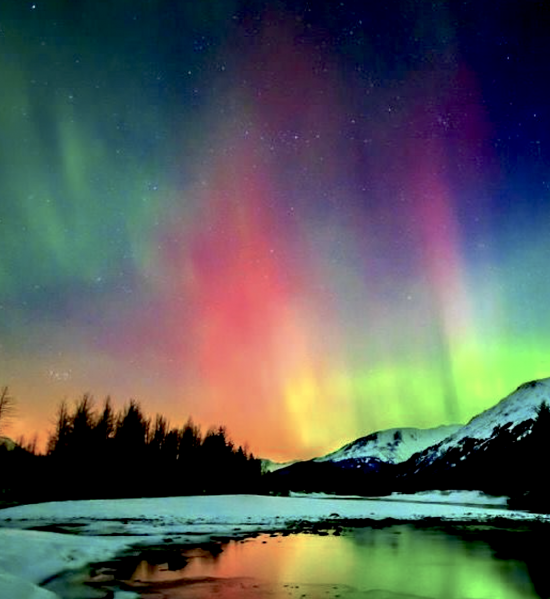
August 17, 2020
Earth’s northern lights are entrancing, but puzzling.
In 1621 Pierre Gassendi called the northern curtains of light, “Aurora Borealis” after Aurora, the Roman goddess of dawn, and Boreas, the Greek name for the north wind.
Earth’s magnetic field contains an electrically powered structure called a magnetotail (or plasma tail) extending for millions of kilometers from Earth; always pointing away from the Sun. Charged particles, conventionally called the solar wind, are captured by Earth’s magnetosphere, and along with ions generated by Earth, itself, collect in a plasma sheet within the magnetotail, where they are held together by the magnetic field. Solar wind ions follow Earth’s magnetic field down into the poles, causing atmospheric molecules to emit light: red from oxygen at high altitudes, then green from oxygen lower down, along with blue from nitrogen.
According to a recent press release from NASA’s Time History of Events and Macroscale Interactions during Substorms (THEMIS) mission, large areas of the Aurora Borealis are sometimes seen to create intense bursts of light called substorms. “Auroral beads”, are also observed before larger substorms.
Auroral substorms are “knots” of electromagnetic energy (plasmoids) that move in conjunction with plasma jets traveling through the magnetotail. Plasma waves and many types of plasma instability are generated when the jet reaches the magnetotail’s inner boundary. Radar stations in Alaska and Greenland detect return signals from streams of plasma in Earth’s upper atmosphere just before the aurorae collide.
In an Electric Universe, electric charge separation occurs in the upper atmosphere because “tidal winds” move ionospheric plasmas against Earth’s magnetic field, inducing powerful electric fields and charge flow (electric currents). As previously written, the tidal wind charge effect is connected to the Sun by Birkeland currents. Earth’s rotation induces a 140,000 ampere current, with the dynamo region acting as the primary coil, while Earth is the secondary. Transformer action, along with other electromagnetic induction events, creates bands of oppositely charged plasma that move east and west around the planet, following the geomagnetic equator.
Those “field-aligned currents” are Birkeland currents.
In 1903, Kristian Birkeland’s Arctic expedition discovered that electric currents from the Aurora Borealis flowed parallel to the auroral formation. Since electric currents move in a circuit, and since the auroral glow seemed to be caused by events in space, he proposed that they flowed down from space at one end of the auroral arc and back out to space at the other.
Today, Birkeland’s polar electric currents are known as auroral electrojets, and they are connected to a flow of electric charge that follows Earth’s geomagnetic field into and away from the Arctic region. They are the “new” discovery made by NASA scientists who continue to ignore Birkeland’s work. Although the words “plasma” and “currents” are used in the press release, they are coupled with “lava lamp”, “bubbles” and “buoyancy”.
It seems that space scientists are reversing cause (electric currents) and effect (magnetic fields). They downplay or deny the importance of the electrical processes and ignore the work of plasma pioneers like Kristian Birkeland. “New discoveries” are really confirming the work done by pioneers more than 100 years ago.
Stephen Smith
The Thunderbolts Picture of the Day is generously supported by the Mainwaring Archive Foundation.












